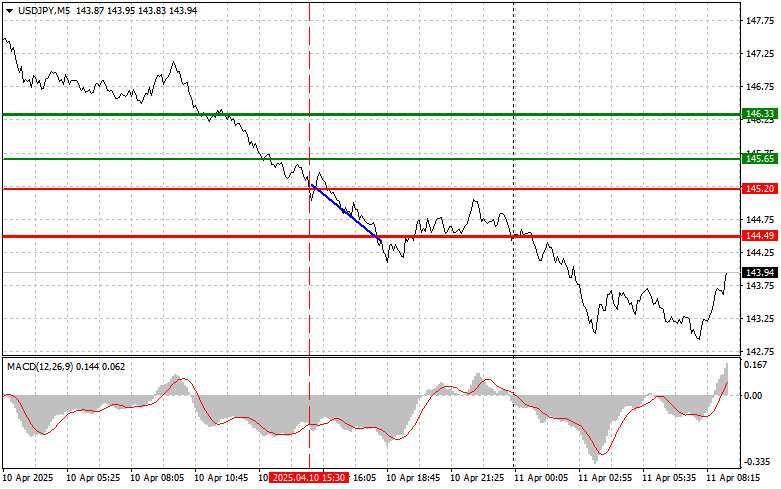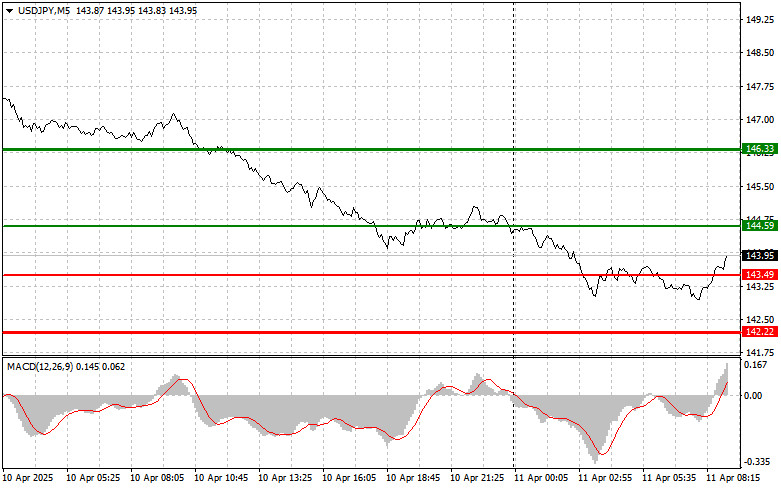See also


 11.04.2025 08:42 AM
11.04.2025 08:42 AMThe price test at 145.20 occurred when the MACD indicator moved significantly below the zero line, limiting the pair's downside potential. However, this did not prevent selling the U.S. dollar, as the test happened after the sharp U.S. inflation slowdown data was released, which weakened the dollar's position.
Contrary to analysts' forecasts, the U.S. Consumer Price Index fell in March instead of rising. This put significant pressure on the U.S. dollar and further strengthened the Japanese yen. There's no need to remind you that the Bank of Japan plans to raise interest rates, unlike the Federal Reserve, which leans toward rate cuts. The current environment allows the Fed to ease monetary policy by cutting rates, potentially stimulating economic growth.
Today's data on the slowdown in Japan's money supply growth had little impact on the market. Traders focus more on global factors such as U.S. inflation expectations and Donald Trump's trade policy.
For intraday strategy, I will focus primarily on implementing Scenarios #1 and #2.
Scenario #1: I plan to buy USD/JPY today at the 144.59 entry point (green line on the chart), targeting a rise to 146.33 (thicker green line on the chart). Around 146.33, I plan to exit long positions and open short positions in the opposite direction (aiming for a 30–35 pip pullback). It's best to return to buying the pair during corrections and deep dips in USD/JPY.
Important: Before buying, ensure the MACD indicator is above the zero line and beginning to rise.
Scenario #2: I also plan to buy USD/JPY today if there are two consecutive tests of 143.49 while the MACD is in the oversold zone. This will limit the downside potential and trigger an upward reversal—expected targets: 144.59 and 146.33.
Scenario #1: I plan to sell USD/JPY today only after the pair breaks below 143.49 (red line on the chart), which should lead to a sharp drop. The key target for sellers will be 142.22, where I plan to exit short positions and open a buy trade in the opposite direction (aiming for a 20–25 pip rebound). Pressure on the pair may return at any time.
Important: Before selling, ensure the MACD indicator is below the zero line and just beginning to decline.
Scenario #2: I also plan to sell USD/JPY today if there are two consecutive tests of 144.59 while the MACD is in the overbought zone. This will limit the pair's upside potential and lead to a reversal downward—expected targets: 143.49 and 142.22.
You have already liked this post today
*The market analysis posted here is meant to increase your awareness, but not to give instructions to make a trade.
The price test at 140.68 occurred when the MACD indicator had already moved significantly above the zero line, which, in my view, limited the pair's upside potential. For this reason
The test of the 1.3356 price level coincided with the moment when the MACD indicator had just started moving downward from the zero mark, confirming a correct entry point
The test of the 1.1460 price level in the second half of the day coincided with the MACD indicator starting to move downward from the zero line, confirming the correct
Ferrari F8 TRIBUTO
from InstaTrade
E-mail/SMS
notifications

Your IP address shows that you are currently located in the USA. If you are a resident of the United States, you are prohibited from using the services of InstaFintech Group including online trading, online transfers, deposit/withdrawal of funds, etc.
If you think you are seeing this message by mistake and your location is not the US, kindly proceed to the website. Otherwise, you must leave the website in order to comply with government restrictions.
Why does your IP address show your location as the USA?
Please confirm whether you are a US resident or not by clicking the relevant button below. If you choose the wrong option, being a US resident, you will not be able to open an account with InstaTrade anyway.
We are sorry for any inconvenience caused by this message.


